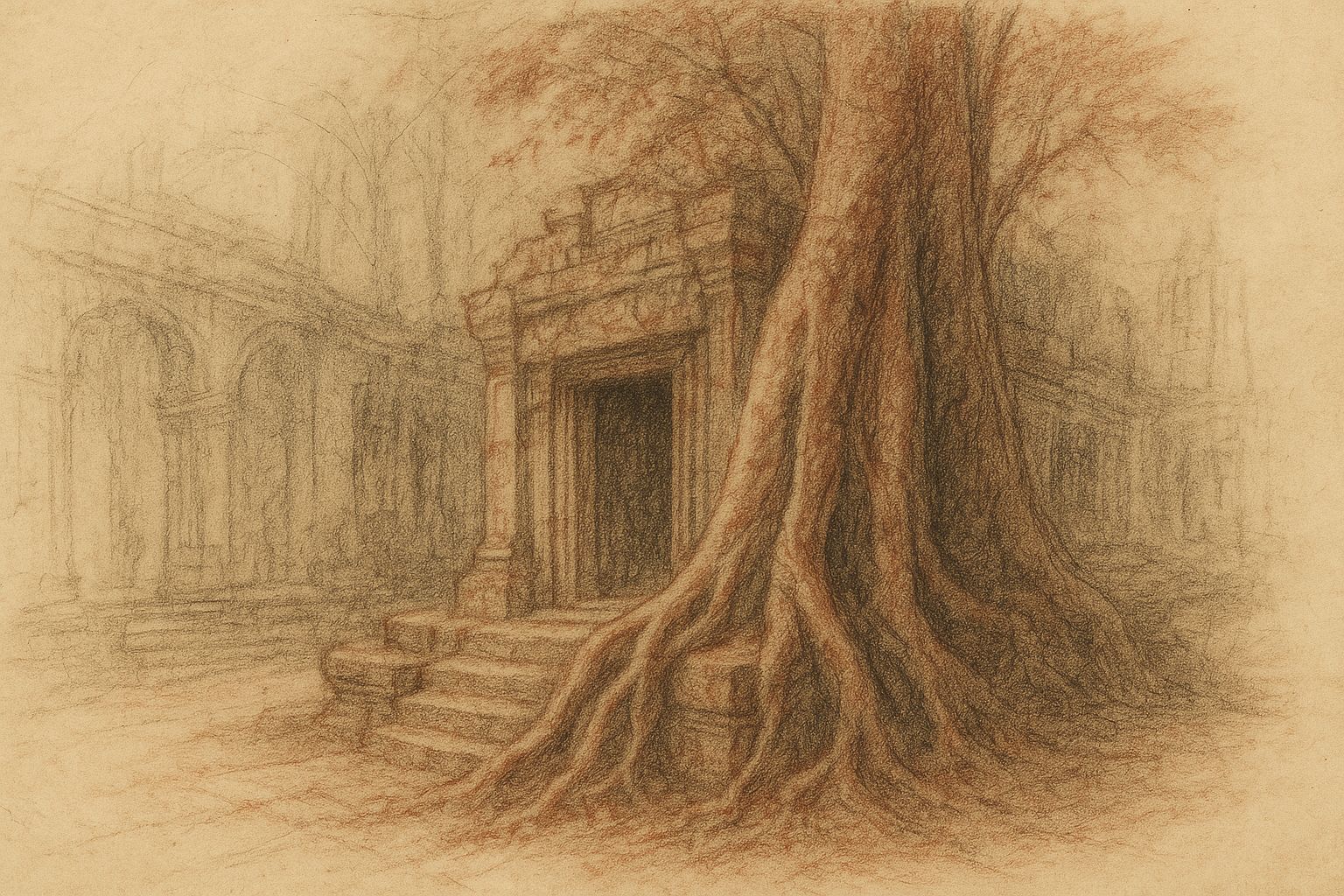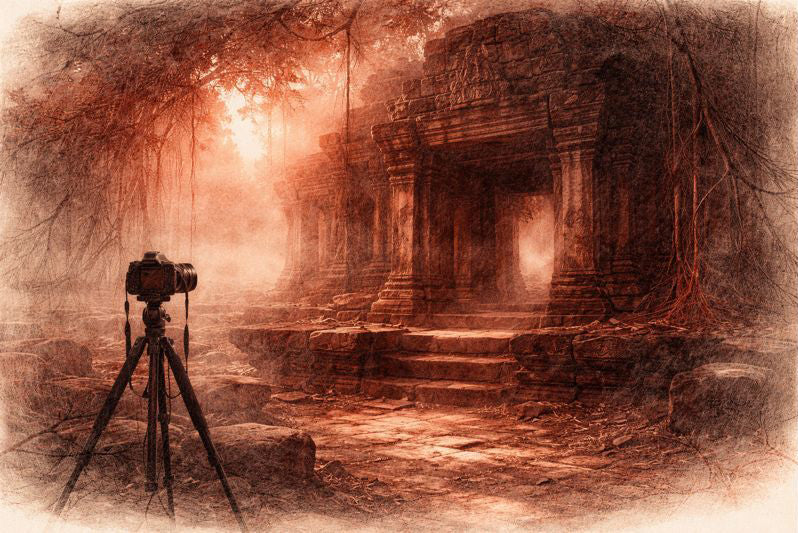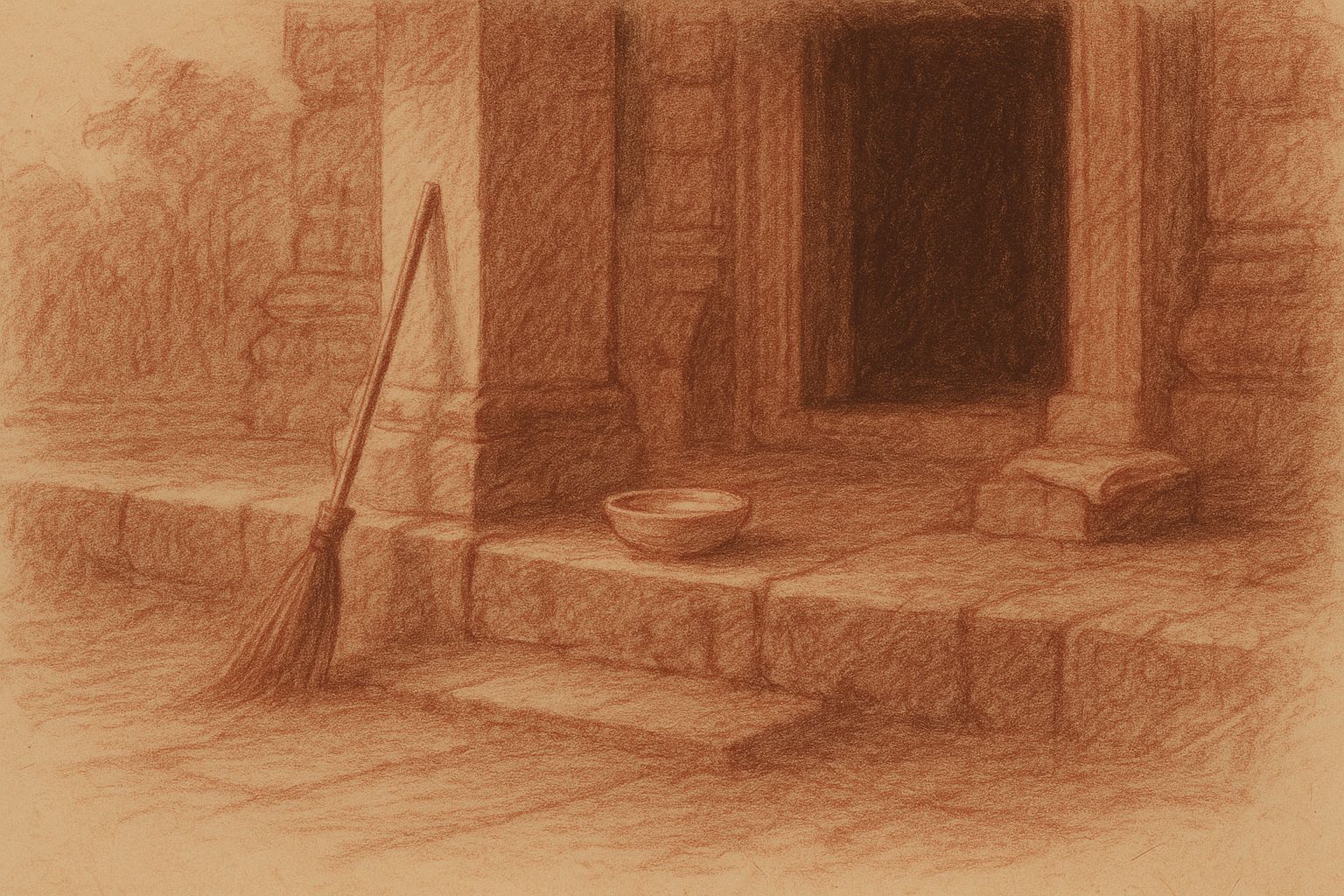Complimentary worldwide shipping on orders over $400 · No import tariffs for most countries
Complimentary worldwide shipping on orders over $400 · No import tariffs for most countries

Roots That Remember — Ta Prohm and the Patience of Trees
In silence, even stone begins to breathe. The roots are listening.
Morning light seeps through the canopy like slow water. I walk the narrow causeway toward the gate of Ta Prohm, where trees have grown not beside the temple but through it — columns of living bark twined with pillars of sandstone. The air smells of moss and dusted wood. Beneath my feet, the earth feels soft, as if remembering the weight of centuries.
At first glance it is ruin — the famed temple of trees, all entanglement and collapse. Yet as I stand before it, a slower rhythm begins to unfold. The trees are not devouring the stones; they are holding them. Silk-cotton roots, pale and muscular, descend the walls like patient hands. What human masons began, these quiet artisans have continued, weaving shelter from surrender.
Each corridor hums with the pulse of green light. The carvings — apsaras, garlands, lotus-columns — fade into shadow, reappearing where a shaft of sun falls between leaves. No sound but the fall of a seed, the breath of a cicada. I find myself lowering my voice, as if speaking in a library built of wind and time. Here the dialogue is older than kings: growth answering gravity, root answering ruin.
I pause before a doorway half sealed by trunk and vine. It is not a barrier but a gesture — the forest leaning in to listen. Inside, the air is cool and scented faintly of iron and rain. A fallen lintel lies across the floor, its inscriptions softened but still legible in places. My hand follows one groove and touches sap. Life has written over language. Perhaps this is how memory survives — not in the clarity of script, but in the persistence of touch.
We speak often of restoration — the desire to reclaim order from decay. Yet in Ta Prohm, order and decay share the same breath. The roots do not rebuild; they reconcile. Each tendril follows a crack, each trunk props what might have fallen. The architecture remains not despite the trees but because of them. Their patience teaches another symmetry — not measured by compass or plumb line, but by the slow equilibrium of giving way.
—
Noon burns through the canopy, sudden and bright, startling the stillness. A tourist’s voice echoes from the outer court — laughter where prayer once lingered — then fades into the hum of insects. Even interruption becomes part of the rhythm, absorbed by the trees.
As the light shifts, so does understanding. Above the collapsed galleries, figs and banyans crown the sky; their roots knit the fallen stones into quiet accord. Every branch feeds the next, every leaf that falls nourishes the root that steadies the wall. The forest keeps the temple alive through a pulse of exchange — the same principle the builders knew when they traced the mandala of Meru upon the ground. What they carved in geometry, the forest completes in breath.
Near the east gallery I meet an old groundskeeper sweeping leaves with a palm broom. He nods toward the roots and says softly, “They hold everything together.” His Khmer words are few, but the gesture stays — one hand resting on the trunk as if in benediction. Then he moves on, the rhythm of his sweeping blending with the whisper of leaves overhead.
Sometimes I imagine the sculptors who first set these stones. Did they foresee this joining — trunk into tower, leaf into lintel? Or did they already know that sanctity requires surrender? To build in Angkor’s climate was always to negotiate impermanence. The forest was never an intruder; it was the eventual breath of every wall. Ta Prohm is the completion of their gesture — stone returning to its first humility.
—
Late afternoon gathers gold in the leaves. I sit upon a fallen block, tracing the fine web of lichen across its surface. Each speck, each green vein, contains its own tiny cosmos. The forest is patient because it remembers — not through mind but through continuity. When a branch falls, another takes its light. When a wall crumbles, a root fills its absence. Memory is not an act of holding on, but of becoming part of what endures.
The longer I stay, the more porous time becomes. The trees grow; the stones yield; the two are indistinguishable. The pilgrim who tries to separate them has already misunderstood the teaching. What we call decay is simply form finding new form. The patience of trees is not the refusal of change, but the faith that everything will return to wholeness when allowed to follow its natural curve.
Evening descends without sound. The last light touches the crown of a strangler fig and slides down into shadow. I walk back through the corridors, my hand trailing along walls furred with moss. In the dimness, each root becomes a script of devotion — cursive lines drawn by time itself. The forest writes its psalm in silence, and the temple replies with patience. Between them lies the lesson: endurance is not resistance, but listening.
When I step once more into open air, I feel the body’s slow recall of belonging — root to soil, breath to breath. Ta Prohm recedes behind me, half stone, half forest, entirely alive. What remains is not nostalgia but gratitude: that the world still knows how to mend itself through patience, and that memory, when left in the care of trees, never truly fades.
—
Sometimes the most faithful act is simply to let the living and the lasting intertwine.
Also in Library

Before the Shutter Falls
3 min read
Before the shutter falls, fear sharpens and doubt measures the cost of waiting. In the quiet hours before dawn, the act of not-yet-beginning becomes a discipline of attention. This essay reflects on patience, restraint, and the quiet mercy that arrives when outcome loosens its hold.

Those Who Keep the Way Open — On the Quiet Guardians of Angkor’s Thresholds
3 min read
Quiet gestures shape the way into Angkor — a swept stone, a refilled bowl, a hand steadying a guardian lion. This essay reflects on the unseen custodians whose daily care keeps the thresholds open, revealing how sacredness endures not through stone alone, but through those who tend its meaning.

Multiplicity and Mercy — The Face Towers of Jayavarman VII
5 min read
A new vision of kingship rises at the Bayon: serene faces turned to every horizon, shaping a world where authority is expressed as care. Moving through the terraces, one enters a field of steady, compassionate presence — a landscape where stone, light, and time teach through quiet attention.
Join My Studio Journal
Receive occasional letters from my studio in Siem Reap—offering a glimpse into my creative process, early access to new fine art prints, field notes from the temples of Angkor, exhibition announcements, and reflections on beauty, impermanence, and the spirit of place.
No noise. No clutter. Just quiet inspiration, delivered gently.
Subscribe and stay connected to the unfolding story.

Join My Studio Journal
Receive occasional letters from my studio in Siem Reap—offering a glimpse into my creative process, early access to new fine art prints, field notes from the temples of Angkor, exhibition announcements, and reflections on beauty, impermanence, and the spirit of place.
No noise. No clutter. Just quiet inspiration, delivered gently.
Subscribe and stay connected to the unfolding story.
